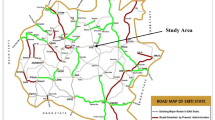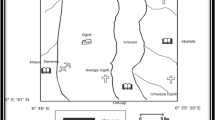Abstract
Electrical geophysical surveys in the mode of vertical electrical soundings (VES) and continuous vertical electrical soundings (CVES) were conducted in the León-Chinandega plains, northwestern Nicaragua, in order to obtain detailed information about the geometry of the different hydrogeological layers in the aquifer and depth to the basement. A total of 51 VES were carried out within the plains. The results show a complex structure towards the north east of the area, and the southwestern part of the plains presents a smoother stratification. The geoelectrical measurements and borehole information indicate that the basement topography is characterized by hills and deep valleys with highly variable basement depths. Fifty CVES where done in a smaller area in the center of the plain. The resistivity data yielded considerable information revealing the existence of two main geo-electrical units. The combined interpretation of geological and geophysical data shows an environment typical of sedimentary volcanic coastal plains. The information collected during this investigation provides valuable data for estimating the fresh-water resources of the León-Chinandega aquifer system and for development of a groundwater management plan.
Résumé
Des études géophysiques électriques de types sondages electriques verticaux (VES) et sondages electriques verticaux continus (CVES) ont été réalisées dans les plaines de León-Chinandega, dans le Nord-Ouest du Nicaragua, de manière à obtenir des informations détaillées sur la géométrie des différentes couches hydrogéologiques de l’aquifère ainsi que la profondeur du socle. Un total de 51 VES a été réalisé dans les plaines. Les résultats montrent une structure complexe vers le Nord-Est de la zone, tandis que la partie Sud-Ouest des plaines présente une stratification plus douce. Les mesures géo-électriques et les informations des forages indiquent que la topographie du socle est caractérisée par des collines et des vallées profondes avec des élévations du socle très variables. Cinquante CVES ont été réalisés dans une zone plus petite au centre de la plaine. Les données de résistivité ont apporté des informations considérables révélant l’existence de deux unités géo-électriques principales. L’interprétation combinée des données géologiques et géophysiques caractérise un environnement typique de plaines côtières sédimentaires volcaniques. L’information collectée lors de cette étude apporte des données qui peuvent servir à l’estimation des ressources en eau douce du système aquifère de León-Chinandega et à l’élaboration d’un plan de gestion des eaux souterraines.
Resumen
Estudios geoelectricos en la modalidad de sondeos eléctricos verticales (SEV) y sondeos eléctricos verticales continuos (SEVC) fueron realizados en la planicie de León-Chinandega, nor-oeste de Nicaragua, para obtener información detallada de la geometría de las diferentes capas hidrogeológicas en el acuífero y la profundidad al basamento. Un total de 51 SEV fueron realizados en la planicie. Los resultados muestran una estructura compleja hacia el nor-este del área, la parte sur-oeste de la planicie presenta una estratificación más simple. Las mediciones geoeléctricas y la información de pozos indican que la topografía del basamento está caracterizada por colinas y valles profundos con grandes variaciones en las profundidades del basamento. Cincuenta SEVC fueron realizados en un área más pequeña en el centro de la planicie. Los datos de resistividad brindaron considerable información revelando la existencia de dos unidades geoeléctricas principales. La interpretación combinada de los datos geológicos y geofísicos muestra un ambiente típico de las planicies volcano-sedimentarias costeras. La información obtenida durante esta investigación provee información valiosa para la estimación de los recursos de agua potable del sistema acuífero de León-Chinandega y para el desarrollo de un plan de manejo de las aguas subterráneas.













Similar content being viewed by others
References
Alvarez JA (1994) Níveis de Contaminacão das Águas da Bacia do Rio Atoya por Resíduos de Pesticidas Organoclorados e Organofosforados Aplicados na Cultura do Algodão: Bacia do Rio Atoya, Chinandega, Nicaragua, América Central [Levels of contamination in the waters of Rio Atoya Basin due to organochlorinated and organophosphorated pesticides residues applied by cotton cultivation: Rio Atoya Basin, Nicaragua, Central America]. Tese de Mestrado, Universidade Federal do Pará, Belem, Brazil, 132 pp
ARCAL XXXI (1999) Informe de Nicaragua: Estudio Isotopico y de la Contaminación del Acuifero León-Chinandega, Nicaragua [Nicaragua report: isotopic and contamination study of the León-Chinandega aquifer, Nicaragua]. Arreglos Regionales Cooperativos para la Promoción de la Ciencia y la Tecnologia Nucleares en America Latina y El Caribe, Lima, Peru, 52 pp
Cáceres V (2005) Caracterización de las Propiedades Resistivas de los Acuíferos Someros en la Zona Central de la Planicie de León-Chinandega [Characterization of the resistivity properties of shallow aquifers in the central part of the León-Chinandega Plain]. Tesis de grado, Facultad de Ciencias e Ingenierías, Universidad Nacional Autónoma de Nicaragua, Nicaragua, 108 pp
Calderón H (2003) Numerical modeling of the groundwater flow system in a sub-basin of the León-Chinandega Aquifer, Nicaragua. MSc Thesis, Department of Geology and Geophysics, University of Calgary, Canada, 206 pp
Christensen NB, Auken E (1992) Simultaneous electromagnetic layered model analysis. In: Jacobsen BH (ed) Proc. Interdisciplinary Inversion Workshop 1, Aarhus, Denmark, September 1992, GeoSkrifter 41, Aarhus University, Denmark, pp 49–56
CIGEO (1999) Estudio Geofísico de Resistividad Eléctrica entre las subcuencas de los ríos Chiquito y El Realejo, NW de Nicaragua, Volumen I [Geophysical survey by electrical resistivity methods within the sub-basin of Rio Chiquito and El Realejo, NW Nicaragua, vol 1]. Centro de Investigaciones Geocientíficas, CIGEO, UNAN-Managua, Managua, Nicaragua, 91 pp
Corriols M (2003) Hydrogeological, geophysical and hydrochemical investigations in the León-Chinandega Plains, Nicaragua. Licentiate Thesis LUTVDG/(TVTG-1013-SE, Lund University, Sweden, 156 pp
Dahlberg C, Odebjer W (2002) Investigation of hydrochemical characteristics and pesticide concentrations in groundwater at Posoltega, León-Chinandega Plains, Nicaragua: a minor field study. MSc Thesis, LUTVDG/TVTG-5077-SE. Lund University, Sweden, 157 pp
Dahlin T (2001) The development of DC resistivity imaging techniques. Comput Geosci 27:1019–1029
Delgado V (2003) Groundwater flow and water quality in a coastal plain aquifer in northwestern Nicaragua. MSc Thesis, University of Calgary, Canada, 177 pp
Elming S-Å, Layer P, Ubieta K (2001) A paleomagnetic study and age determinations of tertiary rocks in Nicaragua, Central America. Geophys J Int 147:294–309
Fenzl N (1983) Estudio de la Intrusión Marina en los Acuíferos Costeros de la Región León-Chinandega [Marine intrusion study in the coastal aquifers of the León-Chinadega Region]. Instituto Nacional de Estudios Territoriales, INETER, Managua, Nicaragua, 34 pp
IAEA (1971) Report on Environmental Isotope Studies. UNDP, International Atomic Energy Agency Special Fund Project NIC-8, Nicaragua. IAEA, Vienna, Austria, 12 pp
INETER (2001) Estudios Hidrológicos e Hidrogeológicos en la Región del Pacífico de Nicaragua: Fase I, Región Chinandega-León-Nagarote, Informe Final [Hydrologic and hydrogeologic studies in the Pacific region of Nicaragua: phase 1, Chinandega-León-Nagarote Region]. Final Report, Instituto Nacional de Estudios Territoriales, INETER, Managua, Nicaragua, 52 pp
Kuang J (1971) Geología de la Costa del Pacífico de Nicaragua [Geology of the Pacific coast of Nicaragua]. Report No. 3, Geographical Survey of Nicaragua, Managua, Nicaragua
Loke MH (2004) RES2DINV, Rapid 2-D resistivity & IP inversion using the least-square method. Software manual, Geotomeo Software, Penang, Malaysia, 133 pp
Loke MH, Acworth I, Dahlin T (2003) A comparison of smooth and blocky inversion methods in 2-D electrical imaging surveys. Explor Geophys 34(3):182–187
Lopez A, Lacayo M, Cuadra J, Picado F (2000) Estudio de la Contaminación por Plaguicidas en el Acuífero y Suelos de la Región León-Chinandega, Nicaragua [Study of the pesticides pollution in the Aquifer and Soils of the León-Chinandega Region, Nicaragua]. Internal report, Centro para la Investigación en Recursos Acuáticos de Nicaragua, CIRA-UNAN, Managua, 20 pp
McBirney A, Williams NS (1965) Volcanic history of Nicaragua. University of California Press, Berkeley, CA, 63 pp
Oldenburg DW, Li Y (1994) Inversion of induced polarisation data. Geophysics 59:1327–1341
Payne BR, Yurtsever Y (1973) Environmental isotopes as a hydrogeological tool in Nicaragua. IAEA-SM-182/19, Department of Research and Isotopes, IAEA, Vienna, Austria, pp 195–202
Ryom M (2004) TemFast48 test and investigations in Nicaragua. MSc Thesis, University of Aarhus, Denmark, 143 pp
Tsourlos P (1995) Modeling interpretation and inversion of multielectrode resistivity survey data. PhD Thesis, University of York, UK, 315 pp
United Nations (1974) Investigaciones de Aguas Subterráneas en la Región del Pacífico de Nicaragua, Volumen I: Zona de Chinandega [Groundwater investigations in the Pacific region of Nicaragua, vol 1: Chinandega Zone]. UN, New York, 120 pp
Väisänen U, Kukkonen M, Rainio H, Pirkko L, Ulmos M, Balmaceda L, Guzman F, Larios R (2001) Problemas Ambientales en las Zonas de Tisma, León-Posoltega, Diriamba y Santo Tomas-La Libertad en Nicaragua [Environmental problems in the zones of Tisma, León-Posoltega, Diriamba and Santo Tomas-La Libertad, Nicaragua]. GTK and MTT, Finland, Universidad Nacional Agraria, UNA, Managua, Nicaragua
Wilson TC (1942) Geology of the Pacific coast area, Nicaragua. Summary report, Geological Survey of Nicaragua, Managua, Nicaragua
Zhou B, Dahlin T (2003) Properties and effects of measurement errors on two-dimensional resistivity imaging surveying. Near Surface Geophys 1(3):105–117
Zoppis-Bracci L, Del Guidicce D (1958) Geología de La Costa del Pacifico de Nicaragua [Geology of the Pacific Coast of Nicaragua]. Bol Servic Geol Nacional 2:24–68
Acknowledgements
This investigation was performed with economic support from the Swedish International Development Authority (SIDA/SAREC), as part of a multi disciplinary co-operation program between Lund University and the Autonomous University of Nicaragua (UNAN-Managua). We also want to thank INETER (Nicaraguan Institute of Territorial Researches) for supporting part of the field-work investigation in this area.
Author information
Authors and Affiliations
Corresponding author
Rights and permissions
About this article
Cite this article
Corriols, M., Dahlin, T. Geophysical characterization of the León-Chinandega aquifer, Nicaragua. Hydrogeol J 16, 349–362 (2008). https://doi.org/10.1007/s10040-007-0262-1
Received:
Accepted:
Published:
Issue Date:
DOI: https://doi.org/10.1007/s10040-007-0262-1




